Which Of The Following Is Not One Of The Changes That Happen In The Maternal Body During Pregnancy?
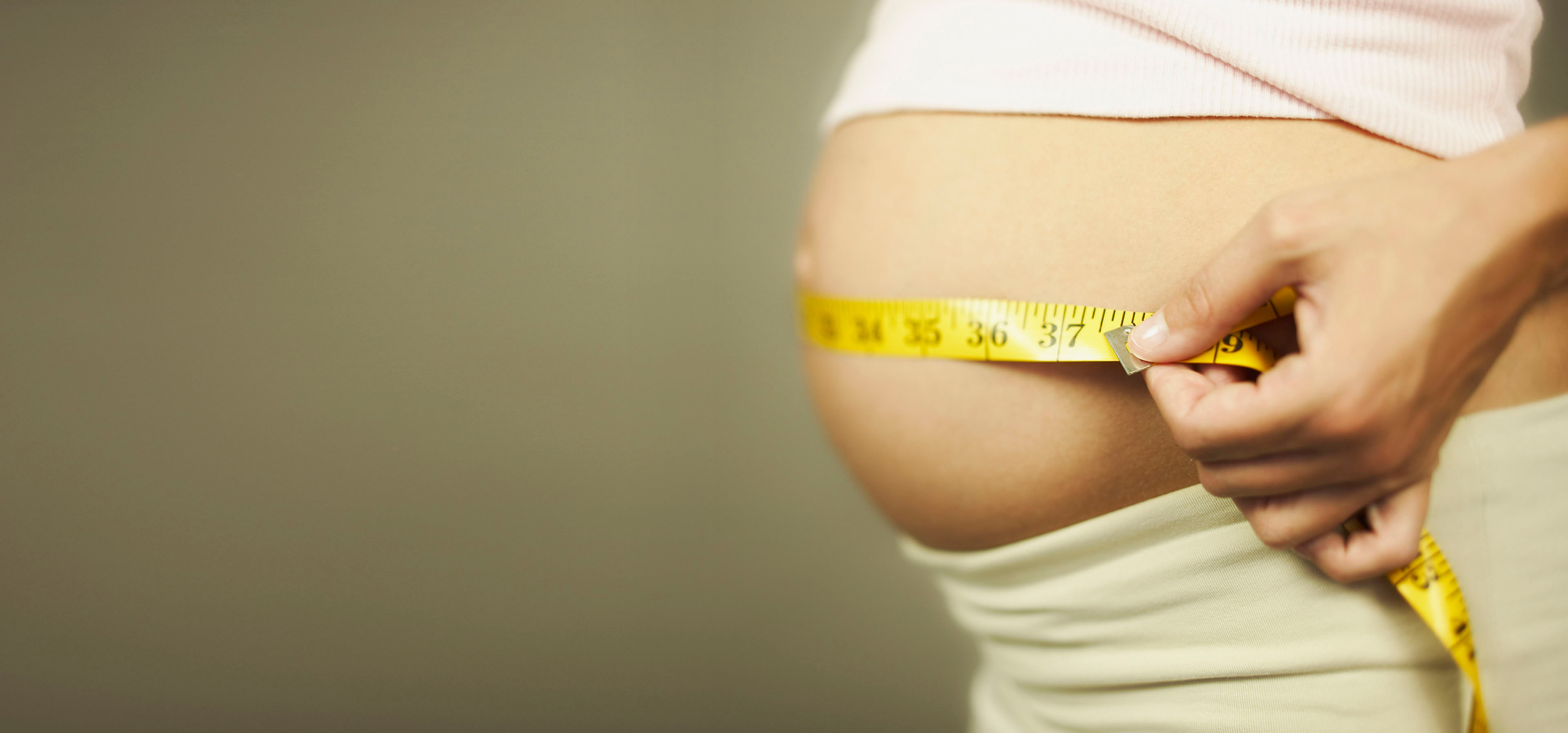
Stages of pregnancy
Pregnancy lasts most 40 weeks, counting from the first day of your concluding normal period. The weeks are grouped into 3 trimesters.(TREYE-mess-turs) Find out what's happening with you and your baby in these three stages.
Beginning trimester (week 1–week 12)
During the get-go trimester your body undergoes many changes. Hormonal changes touch on near every organ organisation in your body. These changes can trigger symptoms even in the very kickoff weeks of pregnancy. Your menstruum stopping is a clear sign that you lot are meaning. Other changes may include:
- Extreme tiredness
- Tender, swollen breasts. Your nipples might also stick out.
- Upset stomach with or without throwing up (morning sickness)
- Cravings or distaste for certain foods
- Mood swings
- Constipation (trouble having bowel movements)
- Need to laissez passer urine more ofttimes
- Headache
- Heartburn
- Weight gain or loss
As your torso changes, you might need to make changes to your daily routine, such equally going to bed earlier or eating frequent, small meals. Fortunately, near of these discomforts will get away as your pregnancy progresses. And some women might not experience whatsoever discomfort at all! If yous have been pregnant before, you might feel differently this time around. Just as each adult female is different, and so is each pregnancy.
2nd trimester (week 13–week 28)
Near women discover the 2nd trimester of pregnancy easier than the get-go. But information technology is just as important to stay informed about your pregnancy during these months.
You might notice that symptoms similar nausea and fatigue are going away. But other new, more noticeable changes to your body are now happening. Your abdomen will expand as the baby continues to grow. And before this trimester is over, you will experience your baby start to move!
As your trunk changes to make room for your growing baby, you may have:
- Body aches, such equally back, belly, groin, or thigh pain
- Stretch marks on your abdomen, breasts, thighs, or buttocks
- Darkening of the pare around your nipples
- A line on the skin running from belly push button to pubic hairline
- Patches of darker skin, usually over the cheeks, forehead, nose, or upper lip. Patches often match on both sides of the face. This is sometimes called the mask of pregnancy.
- Numb or tingling hands, chosen carpal tunnel syndrome
- Itching on the abdomen, palms, and soles of the feet. (Telephone call your doctor if you lot accept nausea, loss of appetite, vomiting, jaundice or fatigue combined with itching. These can exist signs of a serious liver problem.)
- Swelling of the ankles, fingers, and face. (If you lot notice any sudden or farthermost swelling or if you gain a lot of weight actually quickly, phone call your medico right away. This could be a sign of preeclampsia.)
Tertiary trimester (week 29–calendar week 40)
Yous're in the domicile stretch! Some of the same discomforts yous had in your 2d trimester will continue. Plus, many women notice breathing difficult and observe they have to go to the bathroom even more than often. This is because the baby is getting bigger and it is putting more than pressure level on your organs. Don't worry, your babe is fine and these problems volition lessen once you give birth.
Some new body changes you might discover in the tertiary trimester include:
- Shortness of breath
- Heartburn
- Swelling of the ankles, fingers, and face. (If yous detect any sudden or extreme swelling or if yous gain a lot of weight really quickly, telephone call your doctor right away. This could be a sign of preeclampsia.)
- Hemorrhoids
- Tender breasts, which may leak a watery pre-milk called colostrum (kuh-LOSS-struhm)
- Your belly button may stick out
- Trouble sleeping
- The infant "dropping", or moving lower in your belly
- Contractions, which can be a sign of real or fake labor
As yous near your due appointment, your neck becomes thinner and softer (called effacing). This is a normal, natural process that helps the birth canal (vagina) to open during the birthing process. Your doctor will check your progress with a vaginal exam every bit you almost your due engagement. Get excited — the final countdown has begun!
Your developing babe
First trimester (calendar week one-week 12)
At 4 to five weeks:
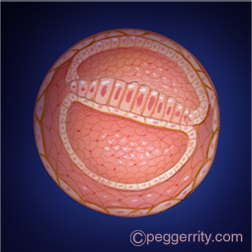
- Your baby's brain and spinal cord accept begun to form.
- The heart begins to class.
- Arm and leg buds announced.
- Your baby is at present an embryo and one-twenty-fifth inch long.
At eight weeks:
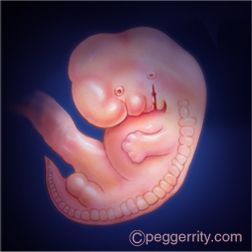
- All major organs and external body structures have begun to grade.
- Your baby's middle beats with a regular rhythm.
- The arms and legs abound longer, and fingers and toes have begun to form.
- The sex activity organs begin to grade.
- The optics have moved forward on the face and eyelids have formed.
- The umbilical cord is clearly visible.
- At the finish of 8 weeks, your infant is a fetus and looks more like a man. Your baby is nigh 1 inch long and weighs less than 1-eighth ounce.
At 12 weeks:
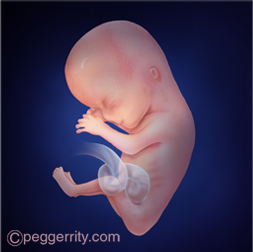
- The fretfulness and muscles brainstorm to work together. Your baby tin brand a fist.
- The external sex organs show if your baby is a male child or daughter. A woman who has an ultrasound in the 2nd trimester or afterward might be able to find out the babe's sex.
- Eyelids shut to protect the developing eyes. They will non open once again until the 28th calendar week.
- Head growth has slowed, and your babe is much longer. Now, at near three inches long, your baby weighs almost an ounce.
2nd trimester (week 13-week 28)
At 16 weeks:

- Muscle tissue and bone continue to form, creating a more complete skeleton.
- Skin begins to form. You tin virtually run into through it.
- Meconium (mih-KOH-nee-uhm) develops in your baby'south abdominal tract. This will be your baby's beginning bowel movement.
- Your baby makes sucking motions with the rima oris (sucking reflex).
- Your baby reaches a length of well-nigh 4 to 5 inches and weighs almost iii ounces.
At 20 weeks:
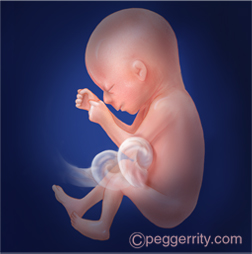
- Your baby is more active. You might feel slight fluttering.
- Your infant is covered by fine, downy pilus called lanugo (luh-NOO-goh) and a waxy coating called vernix. This protects the forming pare underneath.
- Eyebrows, eyelashes, fingernails, and toenails have formed. Your babe can even scratch itself.
- Your baby can hear and swallow.
- At present halfway through your pregnancy, your baby is about 6 inches long and weighs about ix ounces.
At 24 weeks:
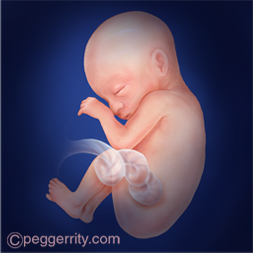
- Bone marrow begins to make claret cells.
- Taste buds form on your baby's tongue.
- Footprints and fingerprints accept formed.
- Real hair begins to abound on your baby's head.
- The lungs are formed, but do non work.
- The hand and startle reflex develop.
- Your baby sleeps and wakes regularly.
- If your baby is a boy, his testicles begin to move from the abdomen into the scrotum. If your infant is a girl, her uterus and ovaries are in identify, and a lifetime supply of eggs take formed in the ovaries.
- Your baby stores fat and has gained quite a bit of weight. At present at about 12 inches long, your baby weighs virtually one½ pounds.
Third trimester (week 29-week 40)
At 32 weeks:
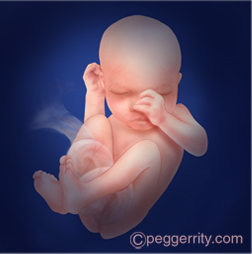
- Your infant'due south basic are fully formed, only still soft.
- Your baby'southward kicks and jabs are forceful.
- The eyes can open and close and sense changes in low-cal.
- Lungs are not fully formed, but practise "breathing" movements occur.
- Your babe's body begins to store vital minerals, such as atomic number 26 and calcium.
- Lanugo begins to fall off.
- Your baby is gaining weight quickly, about half pound a week. Now, your baby is nearly xv to 17 inches long and weighs nigh four to 4½ pounds.
At 36 weeks:
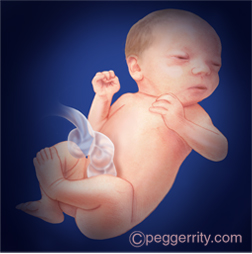
- The protective waxy coating called vernix gets thicker.
- Body fat increases. Your baby is getting bigger and bigger and has less space to move around. Movements are less forceful, just you will feel stretches and wiggles.
- Your baby is nearly 16 to 19 inches long and weighs nigh six to half-dozen½ pounds.
Weeks 37–40:
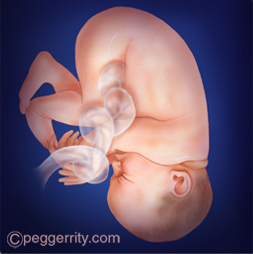
- At 39 weeks, your infant is considered full-term. Your baby's organs are ready to function on their ain.
- As yous about your due date, your baby may plow into a head-down position for birth. Most babies "nowadays" head downwards.
- At birth, your baby may counterbalance somewhere between vi pounds 2 ounces and 9 pounds 2 ounces and be nineteen to 21 inches long. Most full-term babies autumn within these ranges. But salubrious babies come in many dissimilar sizes.
Source: https://www.womenshealth.gov/pregnancy/youre-pregnant-now-what/stages-pregnancy
Posted by: thompsonmecer1954.blogspot.com

0 Response to "Which Of The Following Is Not One Of The Changes That Happen In The Maternal Body During Pregnancy?"
Post a Comment